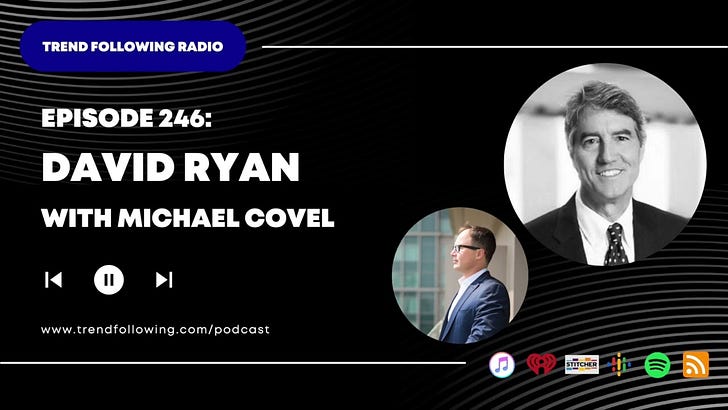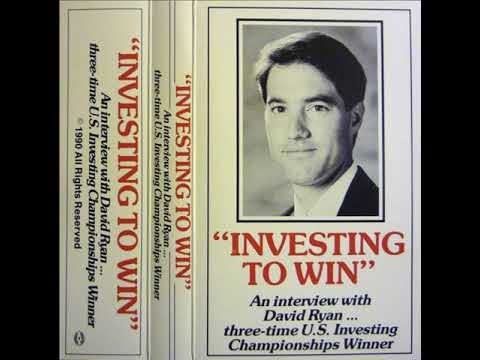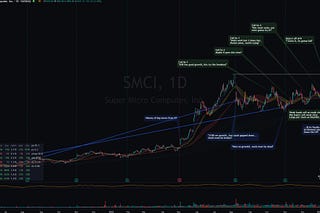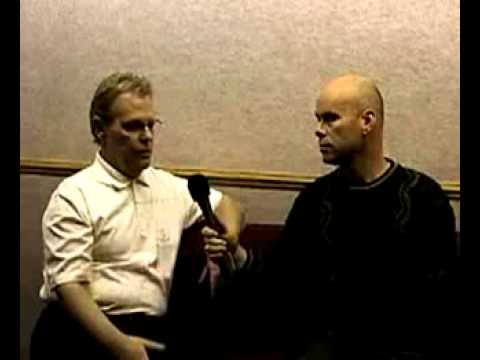David Ryan never buys the lows. Nor does he sell the tops.
In his view, that’s just guesswork. And difficult to do.
Instead, he aims for the middle 50% of a stock’s move. That’s the easiest part to capture, and goes hand in hand with David’s desire to stay in stocks for as long as possible — that is, for as long as they’re acting right.
But how does he do that? More to the point, how has he done this so consistently for over 40 years?
His humility and natural curiosity are a part of it. But mindset is only one piece of the puzzle.
In this final part of my David Ryan series, I’m looking at six more keys to his success:
Buy right
Have sell rules
Don’t diversify
Pyramid into positions
Compound your money
Learn from your mistakes
1. Buy right
First, you need to buy right. That’s in terms of both stock selection and timing entries.
Stock selection
For stock selection, I point you to the CAN SLIM characteristics:
Timing entries
To time your entries well, look for stocks just coming out of big bases and going into new highs — also covered in my CAN SLIM stack above.
When David times his entries like this, in stocks with the right characteristics, he usually finds himself at an immediate profit. As he said in his Market Wizards interview:
“Stocks should be at a profit the first day you buy them. In fact, having a profit on the first day is one of the best indicators that you are going to make money on the trade.”
Or as Dan Zanger says: “Winning horses don’t back up into the gate.”
Strike rate
What is David’s strike rate when taking this approach?
In his 2023 interview with Michael Covel, David said that at 50%, he feels he’s doing a “good” job. At 60%, he’s doing a “fantastic” job.
Interestingly, William O’Neil said in his Market Wizards interview that he closes around two-thirds of his trades at a profit. However, he also found that only 10–20% turned out to be “truly outstanding”.
This corresponds to David’s experiences. Both in his 1990 and recent interviews, he says he only needs a few big winners to have a fantastic year.
And they’re not alone. For example, Qullamaggie only has a 25% strike rate. Even in 2020, when his returns were “insane”, he had a 35% strike rate.
That’s a lower strike rate than O’Neil’s or David’s — perhaps because Qullamaggie focuses less on fundamentals than ‘pure’ CAN SLIM traders. But the same principle applies: you can achieve exceptional returns with relatively few winners, so long as you keep your losses small — more on that later.
“you can achieve exceptional returns with relatively few winners, so long as you keep your losses small”
However, trading profitably with a low strike rate requires confidence.
Traders like David, O’Neil and Qullamaggie are all confident enough in their entry criteria to know that, sooner or later, they’ll get:
The right entry;
In the right stock;
In the right theme; and
In the right market environment.
How do you get that confidence? By studying.
Market orders
One more thing about David’s buying strategy: order types.
Many people think they should place an order at, say, $0.25 below the market to save some money. However, David says that if you think a stock is going to make a major move — which is the only reason you should be buying it to begin with — such pennies won’t make any difference.
He learned this lesson the hard way.
In 1982, he wanted to buy Textone at $14.75, when it was trading at $15. However, the stock never pulled back to $14.75, so his order was never filled.
The next day, the stock jumped to $16.50. David couldn’t bring himself to buy it at that price when he could have bought it for $15 the previous day. He ended up never buying Textone, which ultimately went to $45.
In other words, he missed a triple because he was too greedy.
David has told this story several times. But what he humbly doesn’t talk about is how he obviously stuck to his rules. He didn’t chase and buy an extended stock, but simply learned his lesson and waited for the next opportunity.
2. Have sell rules
David’s main objective is to keep his losses as small as possible. As highlighted earlier, if you keep your losses small, you only need a few good winners to do very well in the markets.
Put differently, when you’re wrong, you want to lose as little as possible.
Then, when you’re right, you should be able to make a lot of money, which makes up for, in David’s words, all the “very small mistakes”.
Stop losses
So, how do you decide when you’ve made a mistake?
You set a stop loss before you buy.
David’s stop losses don’t exceed 7%. Depending on your strategy and average gain, your cut-off may be different. Just make sure your losses don’t spiral out of control to, say, 25% or even 50%.
As David says, you can come up with a thousand excuses for continuing to hold. But holding makes no sense mathematically — something that is down 50% has to double just to get back to breakeven!
So, cut losers as quickly as possible.
This also makes life much easier. To remind you of Qullamaggie’s Chat With Traders interview:
“If I get stopped out, I get stopped out. I don’t think, I just get out. I’ve seen too many scenarios […] when things just keep going lower and […] you hesitate, and now suddenly your stop is twice as big as it would’ve been, and now it’s three times as big and…
“It just […] frees up mental power not to overthink things. I just get in, and I just get out.”
Again, set your stop loss in advance at a sensible level, and when it gets hit, you get out. No excuses.
If you lack the discipline to do this manually, put in a stop order with your broker. (Since I have a day job, and can’t watch the markets all day, that’s what I do. It gives me peace of mind.)
Can that cause slippage? Sure, but then so can manual orders. As David says: if you think the stock’s going to drop significantly, just sell at market. Don’t ask questions.
This will likely improve your results in the long run.
Trailing stops
Once you’re on a profit, you must protect it. David does that by using a trailing stop.
He likes to explain that stocks tend to move like stairs.
Put differently, stocks tend to move up, go sideways, move up again, go sideways again, and so on — just like a staircase. This is something Qullamaggie covered too, with examples.
As stocks move sideways, they tend to build bases (‘stairs’) of at least 6–8 weeks. David normally moves his stop to below the bottom of that stair. As the stock breaks out of that base, and starts building a new stair, he moves up his stop right behind it — a trailing stop.
David stays with a stock so long as it continues to build its ‘staircase’. Once that staircase is broken — in other words, once the stock starts acting wrong — he gets out.
Also, he never sets targets, because you never know how far a stock can go.
Selling before your stop is triggered
In his Market Wizards interview, David said that he sells at least half his position if a stock re-enters its base post-breakout (not if it just comes back to the top of the base).
Why? Because this is another sign that the stock isn’t acting right.
David said to Jack Schwager:
“Frequently, when a stock drops back into its base, it goes all the way back down to the lower end of the base. […] Therefore, you want to cut your losses quickly.”
Again, winning horses don’t back up into the gate.
The other reason David might reduce his positions early is if the overall market starts to act weak.
3. Don’t diversify
Traditional investment advice is along the lines of ‘spread the risk through diversification — hold at least 20 different names in your portfolio’.
If you follow that advice, you can’t keep a close eye on all 20 stocks. Besides, you’ll probably find that half your stocks do well, the other half don’t, so you’ll ultimately make no progress.
The solution is concentration.
David explains that if you hold 4–5 stocks, you can watch them all properly. You can check the charts daily, monitor how the companies and their products/services are doing, and so on. It takes minutes to check 4–5 names.
And if you see a stock performing poorly? You can quickly kick it out, and roll that money into either your better-performing stocks, or a new name.
The exception to the rule
Diversification can be valuable for your overall financial assets. In his 1990 “Investing to Win” interview, David suggested diversifying across cash, bonds, stocks and real estate.
This isn’t uncommon among full-time traders, from what I’ve seen. They may trade full time, but often have another income stream, if only via real estate.
4. Pyramid into positions
David doesn’t tend to buy his full position in one go. Instead, he likes to scale in (also known as ‘pyramiding into a position’). He likes to gradually put his money to work.
He usually starts with a 5% position. With a 7% stop, this works out to 0.35% account risk. He then increases it to a 10% position.
However, David only adds to positions already making him money.
As they say, never throw good money after bad. Or, to quote Paul Tudor Jones, “losers average losers”.
Connecting this to concentration
Coming back to concentration, David doesn’t narrow it down to 4–5 stocks right away.
When a bull market is starting, you can’t yet identify the leaders. David therefore buys 5–7 stocks. Within a few weeks, he narrows those down to the best 4–5 stocks. He may then narrow it down even further to 1–2 stocks.
This allows David to zero in on the strongest stocks in the market.
If you can get into the top 2 stocks, with up to a 50% position in each, you can really make a lot of money if they make huge moves. However, David typically avoids going on margin, as he wants to be able to sleep at night.
In short, David made his great returns by concentrating, not diversifying.
But he doesn’t do this in one go. Instead, he gradually puts his money to work, letting the market tell him whether this is a good time to be invested, and if so, what the best names are.
To hear David himself explain this, listen to this interview (from 4:43):
However, David didn’t link the ideal number of positions to account size. O’Neil did, in Market Wizards:
$5,000: 1–2 positions
$10,000: 3–4 positions
$25,000: 4–5 positions
$50,000: 5–6 positions
$100,000: 6–7 positions
Note that both O’Neil and David don’t exceed seven holdings, and are willing to bring it down to just one good name.
5. Compound your money
In 1985–1987, David achieved annual returns of 161%, 160% and 118%. However, the real magic lies in his three-year compounded return: 1,379%.
Compounding also works very well with smaller accounts, over longer periods of time. In his “Investing to Win” interview, David suggested that you can start small in the markets — even with just $500 or $1,000 — which you then build up while you continue to work.
As he put it (4:26, side A):
“It’s amazing how well you can do if you start compounding your money. If you start getting some very nice returns each year, that small amount of money can really build itself into a very substantial amount.”
The key is to leave that money alone, and just live off your income.
This type of slow, consistent approach to the markets may not get you Qullamaggie-like returns (then again, I think that man is on a different level to the rest of us). However, most people would be more than happy to simply, and consistently, outperform the indices.
David emphasises that it’s better to not approach the markets with the typical mindset of ‘I am going to make a killing this year’, but to look at the market long term. As David points out, O’Neil made his biggest gains when he stayed in a stock for 4–5 years.
6. Learn from your mistakes
In Market Wizards, Schwager asked David whether he felt that he was improving as a trader. David responded:
“Yes. If you try to learn from every single trade that you make, you are only going to get better and better as time goes on.”
Later in the interview, he reiterated:
“Learn from your mistakes. That is the only way to become a successful trader.”
In similar vein, in the second part of “Investing to Win” — a 1990 interview, so it took place shortly after the Market Wizards interview — David was asked whether the ‘average person’ can use the CAN SLIM formula as effectively as he did.
David thought so, but also warned that it takes time to learn. It took him up to two years, and a lot of trial and error, to know exactly when to buy stocks. (And that’s relatively quick!)
But he also underlined that it’s important you learn from every mistake.
Journal
Every time you place a trade, learn from it. When David buys a stock, he writes down:
Why he bought it (i.e. what characteristics that stock had); and
What the market was doing at the time.
David also encourages people to write down their comments and feelings — on a printout of the chart, for example — and file them.
Then, after selling the stock, you should go back to that chart and your notes. Why did you make or lose money? In particular, you should study your mistakes, so you don’t repeat them.
The ‘university of Wall Street’
David likes to refer to investing in the stock market as ‘going to the university of Wall Street’.
Every time you buy a stock and, in particular, every time you lose, you’re paying a ‘tuition’ to the market. And every time you pay tuition, you should be learning a valuable lesson — get your money’s worth!
Then, after years of tuition, you’re ready to graduate. Because you:
Have learned from, and are ready to cut out, all your mistakes; and
Are ready to make a significant amount of money when conditions are good.
As David says:
“If you want to make money in the market, if you want to be successful in anything, you really got to put in a lot of time.”
That, of course, is the simple truth of life that people often don’t want to hear.
Conclusion
In his “Investing to Win” interview, David said:
“You make your best decisions when they’re your own decisions, and you have no one else to blame.”
One of the decisions he made was to stay in stocks for as long as possible. For as long as they’re acting right. He doesn’t like jumping in and out of stocks, as this requires a lot of decision-making.
To me, this mindset seems like a key to being able to trade for as long, and as successfully, as David. It’s about:
Making fewer decisions;
Focusing on compounding;
Committing to the long haul;
Looking for the next big winner; and
Trading in a relaxed and sustainable way.
In short, simplify your trading. Think long term.
More content like this
All my David Ryan stacks are available here.
To visit The Trading Resource Hub’s full archive, click here.















Thank you for this :)
Thank you Kay!
Do you have any advice about how to trade small account? “Micro account”- QQ